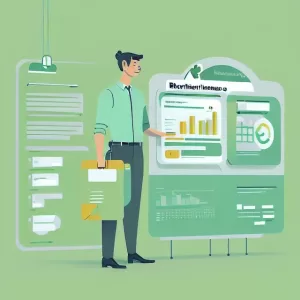The Fast Track Guide to Starting a Business: From Idea to Launch
A five minute guide that will teach you what others take years to learn about how to build a successful business correctly.
This is a quick start guide for those interested in building a business.
This will be an overview for a person starting a business who is overwhelmed and not sure where to begin. The goal of this article is to give you the important takeaways and simple concepts you need to know to get started building your business.
There are other articles on this site that go into much greater detail about each of these processes – explaining more on the steps to build a business – but this article is geared at people who want to know the high-level framework that they need to follow to start a business.
Brainstorming and validating your business idea
 The first step is to have a business idea. You might need help brainstorming the idea and coming up with something suitable for you personally, and for the market.
The first step is to have a business idea. You might need help brainstorming the idea and coming up with something suitable for you personally, and for the market.
After you’ve come up with an idea you’ll need to go through a process of figuring out whether it’s potentially a good idea for you or not.
I talk to lots of entrepreneurs every day who have potentially good ideas but there are truly terrible ideas for the individual founder.
For instance a 19-year-old kid who wants to start his own gaming laptop company manufacturing computers – but he has no knowledge about building laptops, no money and no background in business. It’s a long shot of epic proportions because the founder/knowledge/experience gap is so wide. 🙁
It’s important that the business idea should be well-suited to your skills, and your interests, and your knowledge.
The business idea needs to be viable for you. Do you have the amount of money needed? Do you have the skill needed? Do you have the background needed?
Here are some really important questions to ask yourself:
- Is there a market for my product or service?
- How big is that market?
- Do I have a way to get in front of that market to show off my business?
- How much competition is there?
- Will this business generate enough profit to meet my financial needs?
- What are the financial requirements to get started and can I get the money together to do it all?
- Do I have the skills and experience needed to succeed?
- Are there any legal or regulatory obstacles?
Conducting market research to assess demand and competition
 After you have an idea you need to do some more research and some work to determine whether this idea is something that you’re going to be willing to spend a couple of years of your life on.
After you have an idea you need to do some more research and some work to determine whether this idea is something that you’re going to be willing to spend a couple of years of your life on.
You’re going to need to do market research, you’re going to need to come up with a marketing plan that you can actually execute in the real world, and you’re going to need to figure out things such as your sales strategy.
Another very important thing that you need to do is to determine whether the business has the potential two make enough money for you to be happy.
What I suggest is using a simple financial projection (see the template for this at the link). This is a simple spreadsheet calculator that you can fill-in in a few moments that will give you a guesstimate about what your business revenue and profit might look like after six months, 12 months, and 24 months – it’s a good starting place.
One of the important reasons to do this is that sometimes you find it’s very hard to make a profit based on the idea you have maybe because your cost of running the business or creating the product is too high for what you think you can charge.
Or maybe you just don’t think you can sell enough to create a profit – but this simple financial projection will allow you to see whether the profits you need should be there or not.
Testing your idea – a critically important step
This is the big step that most entrepreneurs miss – but you need to pay close attention 🙂 ! Ensuring that your business idea appears to be solid can make the difference between investing your time and energy into a potential success or a likely failure.
Consider this. You’ve got a business idea that you’re passionate about. You’re ready to dive in headfirst and put in the hard work (like most founders).
But what if the idea isn’t as great as it seems? What if the market doesn’t need, or want, your product or service?
By testing your business idea, you can answer these questions before you invest significant resources.
That’s the power of testing. It offers a chance to validate your idea, ensuring it has a real market and a genuine demand.
But how do you test your business idea? At a high level, it involves gathering and analyzing data. You’ll want to understand your potential customers, competitors, and market conditions. There are a number of ways to do this, including surveys, market research, and even launching a minimal viable product (MVP).
We have a number of resources available to help you with this critical step. For example, our post on how to validate your business ideas effectively is a great place to start. Additionally, our guide on how to conduct a successful focus group test can help you gather valuable consumer insights.
Remember, testing your idea can save you from years of working on a venture that’s destined to fail.
Identifying your target audience and customer persona
Next you’ll need to identify who exactly is your target customer.
And when I say exactly – I really mean specifically – is this a man a woman a teenager, how old are they, where do they live, what kind of behaviors do they have? Do they like sports? Shopping? Tennis? Luxury cars? What are their needs and what are their objectives what cultures do they belong to etc. etc.?
All of these things are important and help you gain insight into who exactly your customer is so that you don’t where you might be able to find them.
Of course it’s all leading up to being able to communicate your value proposition to your customer so that they have the chance to decide whether to purchase your product.
Before we can communicate to the customer we need to know where they are so knowing all of their attributes helps us to know where to look so that we have a chance to communicate with these people, our future customers.
Creating a business plan and financial projections
Creating a business plan is an important part of the planning process, and it doesn’t need to be as scary as a lot of people think.
I suggest a short-form business plan of 1 to 2 pages at the beginning while you’re determining the viability of your business idea and whether you should go through with it and actually build the business.
If you can pass all of those tests for viability and validate the idea on some level to get positive feedback from potential customers and determine how interested they are in your product, then you should probably go on to a more traditional longer form business plan. Typically, this is a document that’s more fleshed out and probably 20 to 30 pages.
The most important thing that a business plan does is force the founder to come to grips with the answers to a lot of important questions about the business such as strategy, marketing plan, sales plan, strengths, weaknesses, who is the competition, where will the funding come from, how long will the funding last, etc.
Sure, it takes a little while to go through all of this, but if you’re going to have any major roadblocks, it’s better to learn it now rather than later, after you’ve spent 6 to 12 months and maybe a considerable part of your savings working on a plan.
So, the business plan is a great way for a founder to learn on paper if there are any massive roadblocks to creating a successful business.
Also, keep in mind that a business plan is not a concrete document or a roadmap that must be followed at all costs.
It is a suggestion and a plan for where the business is going, but a savvy founder will remain flexible as things develop. In that regard, a business plan can change, sometimes a little or sometimes a lot, over time.
Here’s a link to a page with both Short Form 1-2 Page Business Plan template a more traditional longer form Business Plan.
It’s more important to be aware of your progress and changing market conditions or opportunities that you perceive rather than to stick to a business plan blindly.
Launching your business and scaling up over time
Finally, it’s time to launch the business. Presumably, you have tested the product or service with potential customers and received feedback, and iterated based on that feedback.
If you have a website or an app, it needs to be thoroughly tested. People in the real world may not know where to click, look or read, and it’s surprising how they use the website or app differently than you expect. Spend a lot of time testing your business to ensure that everything works properly, cannot be broken, and is intuitive to the customer.
Before launching the product, you’ll want to generate hype and promote the launch to get people excited. Utilize social media channels to build curiosity and generate traffic and engagement for the launch.
Once the product is launched, focus on growing sales and revenue, while also improving processes, efficiencies, and hiring people to help. Adjust your marketing plan as needed and be ready to try different things to improve sales and customer engagement.
Hopefully the customers and the sales will begin to flow, but if they don’t you have to be ready to figure out why – and to try different things.
This is a really common part of launching a business so be ready for it. It’s OK, it’s normal. Don’t give up!
The goal of any business is growth so the final phase of launching is to begin figuring out how to grow your business. First you’ll be focused on growing your sales in your revenue and of course you’ll need to adaptive grow your operations which means hiring people to help, improving processes, improving efficiencies, and adjusting your marketing plan as time goes forward.
Conclusion
I hope this overview has given you a good idea of what’s coming in your business journey. Feel free to reach out on our contact page if you have any questions. Good luck!